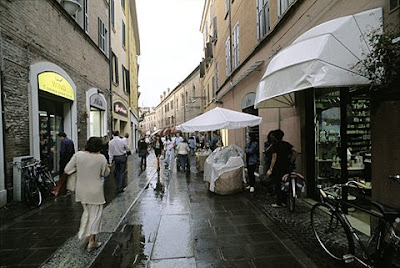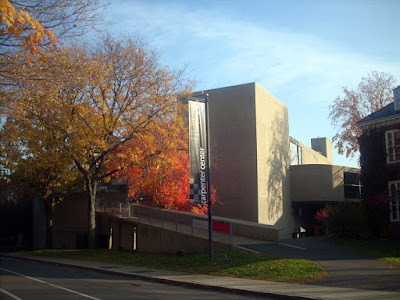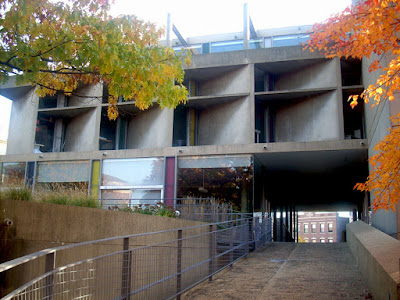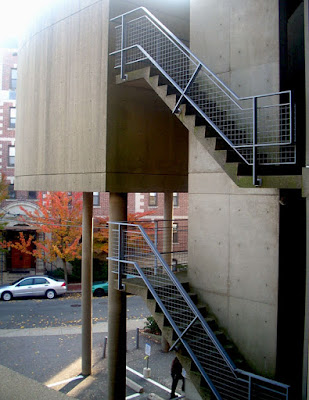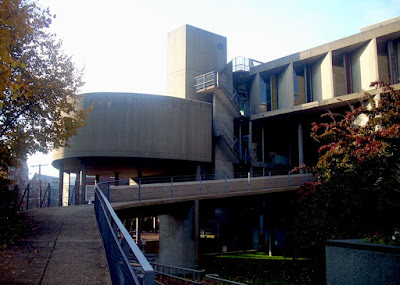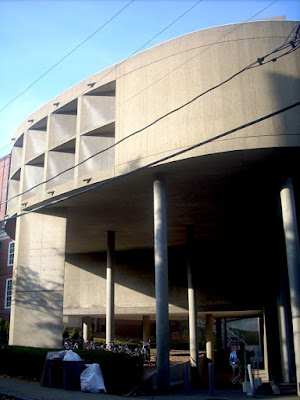Es para mi un placer ser parte de este programa de maestria en SciArc dirigido por mi amigo y colega Peter Zellner. Si les interesa la maestria por favor de comunicarse con Peter o con un servidor.
http://www.sciarc.edu/portal/programs/graduate/scifi/index.html
SCIFI PROGRAM — 1 YEAR (3 TERM)
Southern California Institute for Future Initiatives
1 year (3 Term) Program
Post-professional degree program leading to a Master of Design Research in City Design, Planning and Policy, open to students with a professional degree in Architecture or a Bachelor degree or equivalent in any field. This program requires attendance for the Fall, Spring and Summer terms.
Applications for admission to the 2009–2010 class are due on or before March 4, 2009. See Eligibility and Applications below.
Peter Zellner, Program Coordinator
David Bergman, Program Coordinator
Program Description
Led by Peter Zellner and David Bergman, SCIFI is focused on promoting innovation within design, policy, and planning responses to the economic, social and environmental futures of global cities and regions. SCIFI is dedicated to supporting investigations into the impacts of urban and planning policy, transnational financial markets, real estate speculation, and socio-economic globalization on the evolution of local urban fabrics.
SCIFI provides an integrated curricular focus on urban scale issues. It is positioned as a local, national and international center for the discussion of urban futures, contingent and variable planning strategies and the development of new tools for urban research and design. Combining intensive research into the near term future of cities with the use of new open source design tools, SCIFI aims to invent new ways of modeling and testing variable urban design scenarios.
Program Sequence
Working over three sequenced terms, SCIFI students develop solution-seeking urban research and urban design grounded in the study of the history of the city, urban and regional development methods, city planning and city management tools. Students integrate skills from across SCI-Arc’s programs including design technologies, cultural studies and hard technology applications. The SCIFI program is calibrated to incrementally build research skills, urban design expertise and unique strategic thinking about cities and urban regions. By working from the unique, local and particular to the large, global and generic, SCIFI students gain expertise in the subject of city making through a comprehensive, nuanced understanding of the City’s history and design at all scales. This careful sequencing of context and city-scaled based teaching and intensive workshop based learning is intended inculcate an increasing control over the subject of city formation paralleled by a growing mastery of new urban research methodologies and urban design tools.
SCIFI culminates in the production of thesis design or research projects in the final semester of the SCIFI program. Working individually with SCIFI’s core and visiting Faculty SCIFI students generate deliverables, both individually and as part of a group, that form the basis of a dissertation quality research portfolio. It is envisioned that students will be able to apply these experiences as part of an ongoing dialogue with the city formation process.
SCIFI Core and Visiting Faculty
David Bergman
SCIFI Coordinator
Principal, Economics Research Associates
Wes Jones
Principal, Jones, Partners: Architecture
Eric Kahn
Principal, COA (Central Office of Architecture)
Jeffrey Kipnis
SCI-Arc Visiting Faculty
Professor, Ohio State University
Stephanie Smith
Founder, Ecoshack
Andrew Zago
Principal, Zago Architecture
Peter Zellner
SCIFI Coordinator
Principal, ZELLNERPLUS Design Planning Research
SCIFI Initiatives
SCIFI promotes and extends its academic mission nationally and internationally via its Journal, Public Forums and Global Network. These aligned activities allow SCIFI to widely broadcast its mission as well as to gain feedback for its efforts.
SCIFI Journal
SCIFI cultivates audiences for its research findings within both academic and professional communities by publishing a semi annual journal. The SCIFI Journal invites professional and academic contributions from individuals from the fields of architecture, urban design, planning, real estate development and city management. The SCIFI Journal also provides a record of the SCIFI Public Forums as well as the SCIFI studios‘ academic research and achievements.
SCIFI Public Forums
Each semester the SCIFI program sponsors a public forum in order to generate debate and dialogue around the future of cities and urban regions. SCIFI’s Public Forums provide a means for increasing community interest in the outcomes of the Program’s inquiries into the nature of cities and urban development.
SCIFI Global Network
The SCIFI Network is a global peer-based academic research council dedicated to supporting SCIFI’s academic mission. SCIFI Network members are selected from a field of distinguished practitioners, civic leaders and academics who are exceptionally involved with contemporary urban design issues. The SCIFI Network promotes innovative teaching and content delivery. SCIFI Network members interact with the SCIFI studio via remote web-based conferencing tools thereby providing students with access to a variety individuals not immediately based in the Los Angeles region.
SCIFI Global Network Members 2009-2010
Amale Andraos & Dan Wood
Founders and Principals, Work Architecture Company, New York
Adjunct Faculty, Princeton University School of Architecture
Jose Castillo
Principal of Arquitectura 911sc, Mexico City
Faculty, Universidad Iberoamericana
Facukty, School of Design of the University of Pennsylvania
Odile Decq
D.P.L.G. and D.E.S.S.-Urbanist
Founder and Principal, ODBC, Paris
Director, Ecole Special d’Architecture, Paris
Carol Coletta
President and CEO, CEOs for Cities
Host, Smart City Radio
Joshua Decter
Director, Public Art Studies Program, USC Roski School of Fine Arts
Joseph Grima
Director, Storefront for Art and Architecture, New York
Mark Hinshaw
FAIA FAICP
Principal and Director of Urban Design LMN Architects, Seattle
Jeffrey Johnson
Principal of SLAB Architecture PLLC, New York
Director, China Lab, GSAPP Columbia University
Sam Lubell
Editor, The Architect’s Newspaper – California Edition, Los Angeles
Kieran Long
Editor, The Architect’s Journal, London
Carey Lyon
Founding Director, Lyons, Melbourne
Adjunct Professor, Architecture and Design, RMIT
Past National President of the Royal Australian Institute of Architects
Neville Mars
Architect and Chairman of the Dynamic City Foundation, Beijing
Thom Mayne
Founder and Principal, Morphosis, Los Angeles and New York
Markus Miessen
Principal, Studio Miessen, nOffice, Berlin
Director, Architectural Association Winter School Middle East
Rene Peralta
Architect and Founder, Generica, Tijuana
Associate Professor, Woodbury University School of Architecture, San Diego
Wolf Prix
Founder and Principal, Coop Himmelblau, Los Angeles and Vienna
Chris Reed
Principal Stoss Landscape Urbanism, Boston
Design Critic in Landscape Architecture
Harvard University Graduate School of Design
Ilka Ruby
Architect and Editor, Co-Founder Textbild and Ruby Press, Berlin
Andreas Ruby
Architectural Critic and Theorist, Co-Founder Textbild and Ruby Press, Berlin
Lars-Henrik Stahl
Professor, Department of Architecture and Built Environment
Lund University, Sweden
Visiting Professor, University of Hertfordshire, Great Britain
Chris Stutz
Director, SPACE SYNTAX, London, Great Britain
Roemer van Toorn
Head Projective Theory Berlage Institute, Rotterdam
Faculty, Delft School of Design (DSD)
TU Delft School of Architecture, Holland
Alex Wall
Architect and Chair of Urban Design and Planning
University of Karlsruhe, Germany
Member, Urban Matters Netz
Eligibility and Applications
SCIFI is open to applicants with a professional degree in Architecture or a Bachelor degree or equivalent in any field. SCIFI welcomes interdisciplinary applicants from fields such as architecture, planning, urban design, landscape architecture, real estate and geography.
Applications for admission to the 2009–2010 class are due on or before March 4, 2009.
For information on applying to this program, please contact SCI-Arc’s admissions office

